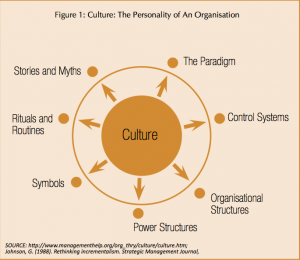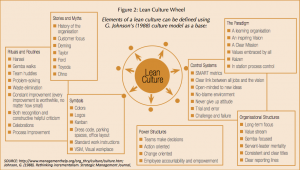It’s not what you think. Or maybe it is. A siloed and matrixed (SM) organisation seeks a simpler formality (SF) for its organisational development. Every relationship goes through changes. How many companies do you know that are looking for something different…a better way, a new product, ways to reduce cost, a new culture? That last one might very well be the toughest nut to crack. A new culture… isn’t that like changing your personality?
Matchmaking a personality, especially a lean personality, to an organisation is tough business. After all, if a lean culture were the right match for every organisation, then every organisation would have one. Variables include values, leadership, history and purpose. The real question is what kind of personality are you seeking?
Before deciding that, there are a few other steps to take in the culture change exercise.
Using Johnson’s model of culture as a base, organisational culture can be explained by telling the organisation’s current rituals and routines, stories and myths, symbols, organisational structure, power structure, control systems and paradigm as shown in Figure 1.

Figure 1
CULTURE CHANGE EXERCISE
Step one. Current state analysis
Before deciding what kind of match is right for your organisation, an essential exercise is the current state culture analysis. Using Figure 1 as a guide, identify current examples of each element in your own organisation. As you do this, do not think about the future, think about examples as the personality is now. What kind of rituals, routines, stories, myths, symbols, organisational structures, etc. exist in your organisation? It is these elements that describe the current culture. Once this has been done you’ll see some things that may be ripe for changing and some things that are working well.
Having done this exercise at several organisations with several different levels of the organisation, many “ah-ha” moments were created, for example, the moment the police force was talking about symbols realising that they still had assigned parking close to the building for the senior leadership and staff instead of customers, the manufacturing facility realising that maybe having separate cafeterias for management and front line employees maybe shouldn’t continue, the healthcare company that realised its history of product safety isn’t used much in its marketing and value statement.
Step two. Compare your current state in step 1 to the lean state
There is often mystery, intrigue and misunderstanding around a lean culture so Figure 2 aims to clarify and simplify what a lean personality looks like. The question is how many elements did you have on your current state analysis? Sometimes there are many and sometimes there are none. In doing this step, it is important to identify which new elements the organisation would like to tackle first. There is no one-size-fits-all answer or approach.

Figure 2
At the end of step two the group has isolated some of the culture elements they’d like to try. This brings to mind the consumer products manufacturer who wanted to start both small and big. They wanted to start with reflection (hansei) sessions every day but also wanted to build a learning organisation. Another firm decided then and there that they would experiment with every senior leader in the organisation being required to lead a training session on a topic of their choice to show that leaders are expected to be teachers.
Step three. Once the desired changes are identified as next steps, then the question to raise is “what are the barriers to piloting these ideas”? This will vary by organisation but common answers are resources, people don’t like change, lack of training, too difficult of a change to make and cannot take time away from the operation. It is important to perform a failure mode analysis for how to address these responses. In the case of the senior leaders above, most of them did not know how to teach and needed a class in training skills.
Step four. The leadership team approves the suggested changes and affected stakeholders do a self- analysis of the coaching, education or experiences they need in order to start to change the personality. Without this, steps one to three are meaningless. It is through this self-analysis that some senior leaders realised it was actually their obligation to pass on knowledge to the organisation in the form of training and many of them had never delivered training throughout their entire career.
The seven elements of the personality of an organisation:
Paradigm – How does the rest of the world see your organisation? How would you describe its image? How does it view itself in the marketplace? Examples: ethical, arrogant, slow, customer focused, employee focused, safety, profit, etc.
Control systems – How are things measured and monitored? E.g. dashboards, how are people rewarded, single person heroics, what does the organisation measure, too many things? Not enough things etc.
Organisational structure – How is your company organised to make your products or deliver your services. E.g. hierarchical, flat, matrixed, team-based, functionally organised etc.
Power structures – How does your company make decisions? E.g. all decisions made at top levels, decisions made by department heads, accountability is throughout the organisation etc.
Symbols – What are some visual symbols, icons, communications, etc. that are associated with your company. E.g. boards, signs, ads, dashboard, safety logo, company logo, colours, parking spots etc.
Rituals and routines – List some common tasks, meetings, activities, events etc. that are done on a repetitive basis. E.g. – daily operations meetings, start-up meetings, team huddles, town hall meetings, annual awards ceremony (are these typically functional or dysfunctional?).
Stories and myths – What are some stories that define what your company stands for? Great things that happened that give you “bragging rights” or unpleasant things that happened that always need to be “explained away”.
CAN A LEOPARD CHANGE ITS SPOTS?
Is it even possible? If you believe that a leopard can change its spots and mountains can move, then yes, it is more than possible, it is promising. Organisational culture as used here is synonymous with personality. Matchmaking a culture to an organisation is a tricky business. That’s why an effective lean leader is part coach, part facilitator and part matchmaker. Here’s to more lean matches made in heaven!


Pingback: The lean culture club | Lean Management Journal...